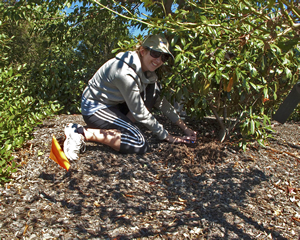
Searching for ants on a sunny afternoon.
Image – Richard Toft©Entecol
When to Look
It is recommended that surveillance is conducted when the ants are most active as this will raise the chance of successfully finding the ants.
Foraging is highly linked to temperature and humidity (Abril et al. 2007). Given appropriate temperature and humidity, Argentine ants can forage throughout the day and night, and in all seasons. During cooler periods, foraging is limited to warmer periods of the day.
Typically, workers forage between 15° and 30°C, and are known to retreat into nests when ground temperature gets too cold or too hot (Markin 1970; Krushelnycky et al. 2005; Abril et al. 2007). Foraging can also be limited by semi-arid conditions and moisture availability (Holway et al. 2002), but these conditions are unusual in New Zealand. Foraging does not occur in heavy rain (Cole et al. 1992), so this should be avoided when sampling.
There is no quantifiable information available but in New Zealand Argentine ants are more active during summer periods (January, February, March); however, depending on conditions they can also be active during winter months, especially in the upper North Island.
Highest activity times during the day are also associated with warmest temperatures. In general sampling between mid-morning and late afternoon is best.
